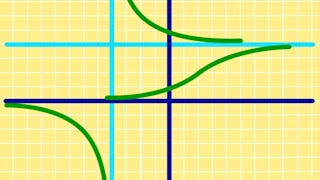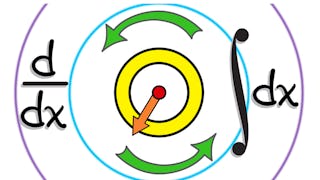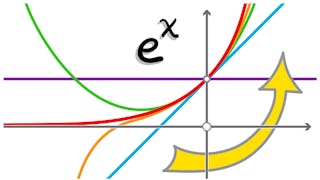The focus and themes of the Introduction to Calculus course address the most important foundations for applications of mathematics in science, engineering and commerce. The course emphasises the key ideas and historical motivation for calculus, while at the same time striking a balance between theory and application, leading to a mastery of key threshold concepts in foundational mathematics.


Introduction to Calculus

Instructor: David Easdown
Top Instructor
280,301 already enrolled
Included with
(3,922 reviews)
Skills you'll gain
Details to know

Add to your LinkedIn profile
56 assignments
See how employees at top companies are mastering in-demand skills

There are 5 modules in this course
This module begins by looking at the different kinds of numbers that fall on the real number line, decimal expansions and approximations, then continues with an exploration of manipulation of equations and inequalities, of sign diagrams and the use of the Cartesian plane.
What's included
10 videos8 readings9 assignments
This module introduces the notion of a function which captures precisely ways in which different quantities or measurements are linked together. The module covers quadratic, cubic and general power and polynomial functions; exponential and logarithmic functions; and trigonometric functions related to the mathematics of periodic behaviour. We create new functions using composition and inversion and look at how to move backwards and forwards between quantities algebraically, as well as visually, with transformations in the xy-plane.
What's included
13 videos12 readings13 assignments
This module introduces techniques of differential calculus. We look at average rates of change which become instantaneous, as time intervals become vanishingly small, leading to the notion of a derivative. We then explore techniques involving differentials that exploit tangent lines. The module introduces Leibniz notation and shows how to use it to get information easily about the derivative of a function and how to apply it.
What's included
12 videos10 readings11 assignments
This module continues the development of differential calculus by introducing the first and second derivatives of a function. We use sign diagrams of the first and second derivatives and from this, develop a systematic protocol for curve sketching. The module also introduces rules for finding derivatives of complicated functions built from simpler functions, using the Chain Rule, the Product Rule, and the Quotient Rule, and how to exploit information about the derivative to solve difficult optimisation problems.
What's included
14 videos13 readings14 assignments
This fifth and final module introduces integral calculus, looking at the slopes of tangent lines and areas under curves. This leads to the Fundamental Theorem of Calculus. We explore the use of areas under velocity curves to estimate displacement, using averages of lower and upper rectangular approximations. We then look at limits of approximations, to discover the formula for the area of a circle and the area under a parabola. We then develop methods for capturing precisely areas under curves, using Riemann sums and the definite integral. The module then introduces indefinite integrals and the method of integration by substitution. Finally, we discuss properties of odd and even functions, related to rotational and reflectional symmetry, and the logistic function, which modifies exponential growth.
What's included
14 videos10 readings9 assignments
Instructor

Offered by
Explore more from Math and Logic

The University of Sydney
 Status: Preview
Status: PreviewThe Hong Kong University of Science and Technology
 Status: Free
Status: FreeUniversity of Pennsylvania
 Status: Free
Status: FreeUniversity of Pennsylvania
Why people choose Coursera for their career




Learner reviews
3,922 reviews
- 5 stars
87.15%
- 4 stars
10.29%
- 3 stars
1.14%
- 2 stars
0.56%
- 1 star
0.84%
Showing 3 of 3922
Reviewed on Jul 20, 2020
The course is amazing, the teacher is incredible that makes the course be cooler and easier to do it. I enjoyed a lot the experience and certainly will help me to develop my professional career.
Reviewed on Apr 2, 2020
Amazing Explanations..... I love how the course is sequenced and it provides not only the mechanical solutions to calculus but also the theories behind each module and topics... Great Course
Reviewed on Dec 12, 2020
Best instructor. Made calculus very approachable connecting topics, illustrating applications, and his enthusiasm (which is contagious). Wish he'd do follow-up courses for more advanced mathematics.

Open new doors with Coursera Plus
Unlimited access to 10,000+ world-class courses, hands-on projects, and job-ready certificate programs - all included in your subscription
Advance your career with an online degree
Earn a degree from world-class universities - 100% online
Join over 3,400 global companies that choose Coursera for Business
Upskill your employees to excel in the digital economy
Frequently asked questions
To access the course materials, assignments and to earn a Certificate, you will need to purchase the Certificate experience when you enroll in a course. You can try a Free Trial instead, or apply for Financial Aid. The course may offer 'Full Course, No Certificate' instead. This option lets you see all course materials, submit required assessments, and get a final grade. This also means that you will not be able to purchase a Certificate experience.
When you purchase a Certificate you get access to all course materials, including graded assignments. Upon completing the course, your electronic Certificate will be added to your Accomplishments page - from there, you can print your Certificate or add it to your LinkedIn profile.
Yes. In select learning programs, you can apply for financial aid or a scholarship if you can’t afford the enrollment fee. If fin aid or scholarship is available for your learning program selection, you’ll find a link to apply on the description page.
More questions
Financial aid available,

